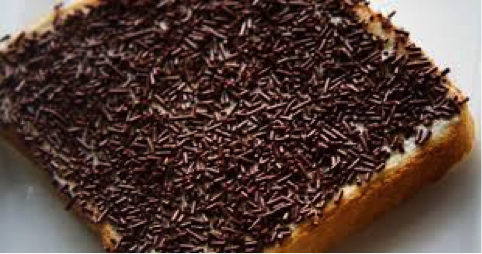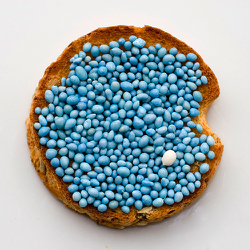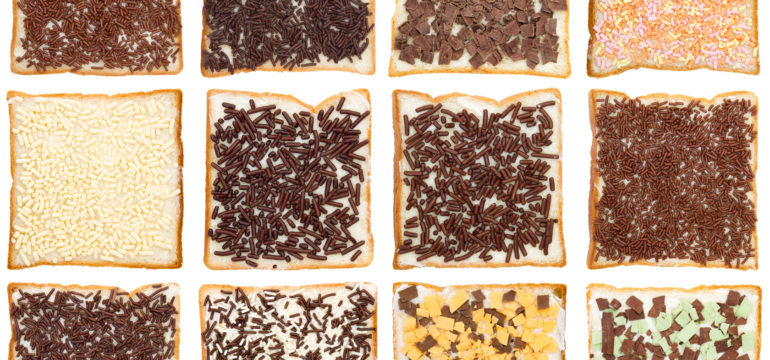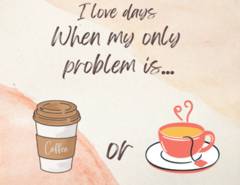 Have you ever heard of Hagelschlag? If so, you are either well traveled or Dutch. You are also very lucky because Hagelshlag is a culturally derived personification of Heaven. Imagine it being perfectly acceptable to put sprinkles (a variety of your own choosing) on buttered bread and call it breakfast (or any meal).
Have you ever heard of Hagelschlag? If so, you are either well traveled or Dutch. You are also very lucky because Hagelshlag is a culturally derived personification of Heaven. Imagine it being perfectly acceptable to put sprinkles (a variety of your own choosing) on buttered bread and call it breakfast (or any meal).

Source: http://adventurefoodie.blogspot.com/2011/02/hagelslag-chocolate-sprinkles.html
The Dutch tradition began in 1919 when a licorice factory in Amsterdam created anise seed flavored sprinkles.1 The sprinkles were created in response to gloomy weather, making the English translation of hagelslag to “hail-storm” make a bit more sense. Other sources cite the invention officially occurring by the company Venz created by Gerard de Vries in 1936.2 However, 1936 was the year the first chocolate hagelslag was created and it was rumored to be in response to letters written by children yearning for a chocolate flavored bread topping.1

Source: http://travelswithyourtastebuds.blogspot.com/2013/05/hagelslag-basicallya-big-box-of.html
The sprinkles were popularized when the Netherland’s royal family was pictured using orange sprinkles called “geboortemuisjes” or “birth mice,” which were a gift upon the birth of Princess Beatrix1. And POOF, the cultural phenomenon was born. The reason mice is part of the title was because the sprinkles resembled mice with their circular nature and having a “tail,” created by the anise the topping is made from. An underlying tradition associated with hagelslag is the use of blue or pink sprinkles for bread décor when celebrating the birth of a child. Dutch blogs suggested anise could promote lactation and guard against evil spirits, but that is unconfirmed.
There are now multiple varieties available now including, chocolate, orange and many other flavors that do not need a special occasion to be consumed. In fact this dish is consumed quite a bit.
The sprinkles are primarily sold in the Netherlands, Belgium, and some former Dutch colonies, but don’t fear you can still order them online here.

Source: http://stuffdutchpeoplelike.com/2011/03/06/hagelslag/
Some additional fun facts about these sprinkles; chocolate versions are often referred to as ‘muizenstrontjes’ or mouse droppings. Also only chocolate sprinkles with at least 32% cocoa may be called chocolate hagelslag and those that do not are called ‘cacaofantasie’ or fantasy cocoa. Most sprinkles are also “UTZ certified” ensuring sustainable cocoa production.1
Traditions like Hagelslag are interesting because of the stories they derive from, but what is most amazing is the longevity of such consumption rituals. A simple dish can create cultural traditions that span for centuries. With the holiday season approaching, food traditions, like those of an American Thanksgiving, are almost always honored in some way or another.
Thanksgiving was invented at the end of the 19th century, often bringing family members together, symbolizing and celebrating ‘family, home and nation.3” Thanksgiving rituals stem from the idea of gathering as a nation to appreciate the founding of the ‘New World’ bonding immigrants and natives alike.3 And as with the above Dutch tradition, the origin of Thanksgiving is also event related but is honored by the consumption of specific foods.
Turkey for example is the centerpiece of most Thanksgiving day feasts because it was native to America and symbolized a plentiful—and conquered—environment.4 The stuffed turkey reportedly symbolized wholeness and the sharing of energy and resources.5 The tradition of feasting has been associated with celebrations of many varieties for some time. The feast also acts as a connection to America’s figurative ancestors, the Pilgrims.3

Source: http://www.ah.nl/producten/ontbijtgranen-broodbeleg-tussendoor/zoet-beleg/hagelslag/merk=De+Ruijter
Ironically the Thanksgiving myth taught to students in school includes the immigration of some unhappy Dutch people from Holland. Their unhappiness must have stemmed from living before the invention of Hagelslag.
As would have it, food scientists are lucky. Food is a centerpiece of countless traditions and constantly being reinvented while honoring the past, underlining the significance of food not just for nutritive purposes but for cultural ones as well. So this year as you consume your favorite holiday dishes, drinks and the like, remember to appreciate not only the flavor, but the story behind your enjoyment!
And just in case you were wondering, you can gain new-found fame from an old time tradition.
References
- http://www.holland-at-home.com/en/food/breakfast-lunch/chocolate-sprinkles-hagelslag/de-ruijter-aniseed-sprinkles-1-pack-of-300-gr.html
- http://adventurefoodie.blogspot.com/2011/02/hagelslag-chocolate-sprinkles.html
- Siskind J. 1992. The invention of thanksgiving A ritual ofAmerican nationality. Critique of Anthropology 12(2):167-91.
- Robertson JO. 1980. American myth, american reality. .
- Abrahams RD. 1982. The language of festivals: Celebrating the economy. Celebration: Studies in Festivity and Ritual :161-77.






Leave a Reply